Good morning everyone, and welcome back to another edition of Marvel Masterpieces Parallels in Masterpiece Theater here on Hipsters of the Coast!
I’m continuing my exploration of Upper Deck’s Marvel Masterpieces from 2016-2020, a continuation of my deep dive into the most recent Marvel Masterpieces 2020 set by Dave Palumbo. As I neared that series completion in 2021, I became curious about how Palumbo’s work would connect to the previous two “modern” Masterpiece sets that came before him. The 2016 set was done by Joe Jusko, artist of the first Marvel Masterpieces set in 1992. And in 2018, the hugely popular Italian comic artist Simone Bianchi followed in his footsteps, and completed his own Marvel Masterpieces set with new characters, new Battle Spectra scenes, and an entirely different stylistic take on the Marvel universe.
Each of the three sets are completely unique, and puts an artist’s style in the full spotlight. Jusko’s look is classic comic book, with all the muscle, color, and vibrancy of the sets from the 1990s, but reimagined with nostalgia for a new century. Bianchi is more contemporary—darker and grittier with bold blacks and colored outlines to make his characters distinct and out of this world. Palumbo falls somewhere in the middle: his big brushstrokes give a painterly feel to the genre, and bring a balance to the modern Masterpieces. His rendition especially is something that trading cards have never seen.
Across the three sets 2016-2020, there are 42 characters that were painted into each set at least once, and several characters that have multiple appearances within a given year.. In total we’ll look at more than 175 artworks throughout this series from each of the last three iterations of Marvel Masterpieces. We’ll compare and contrast each artist’s creation, and learn some pretty cool stuff directly from the artist’s themselves along the way. This series isn’t about picking the best work, but rather talking about why each is a Masterpiece in its own right, and how these works function as a family of premier illustrations both within and across their respective sets.
This article is a bit of a conglomeration, bringing together characters with interesting interactions from within the comic, television, and movies series, and I’ve named it as such. This is Parallels: Daredevil and Friends.
Daredevil
The title character of today’s article is Matt Murdock, known as Daredevil, or “The Man Without Fear.” Blinded in a childhood car accident by radioactive material and raised by a professional boxer and single father, he began to protect his home of Hell’s Kitchen, New York City as he came of age, and the rest is history.
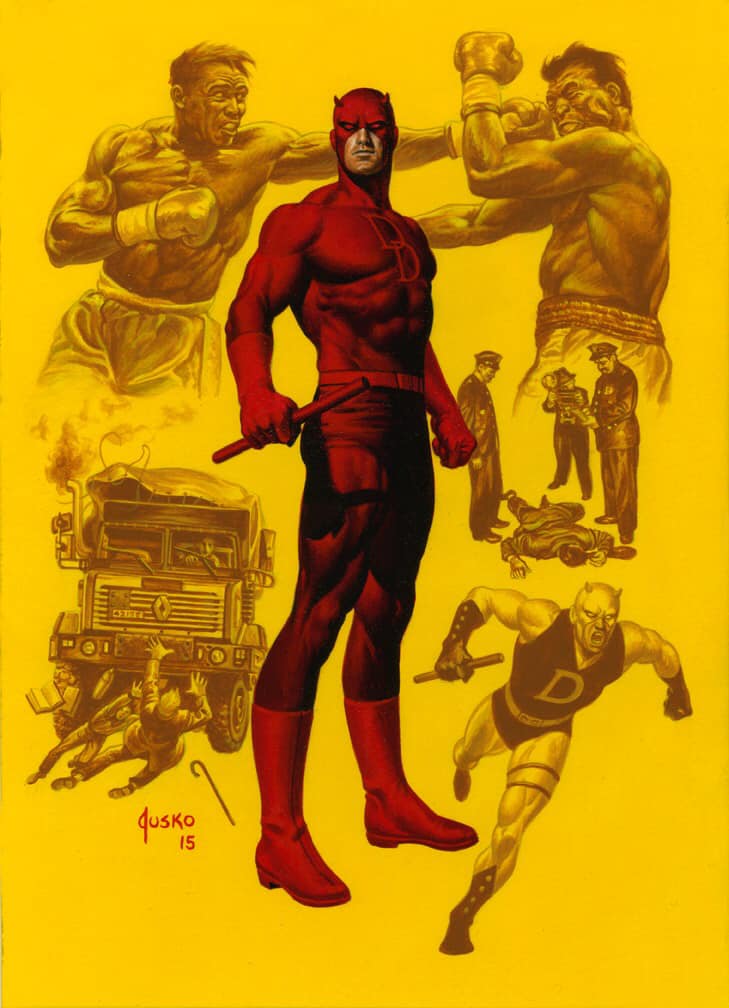
Daredevil (Canvas Gallery) by Joe Jusko, 2016
We’ll begin with one of my favorite works I’ve seen in this series, and it’s one of the artist’s as well. It’s the only time in his book I’ve noticed all caps when he stated “I LOVE THIS CARD,” and he goes on to say he wished he would’ve discovered this idea earlier on so that there could have been more of these “origin story” canvases. We see all manner of Murdock flashbacks, with his father at the top and from the accident that gave him his powers to the vintage yellow and red suit of the 1960s, it’s the entire Murdock story encapsulated in one image. I absolutely love this style and composition, and as much as Jusko would like to do an entire insert series, I think we as fans would love to see it in a future set.
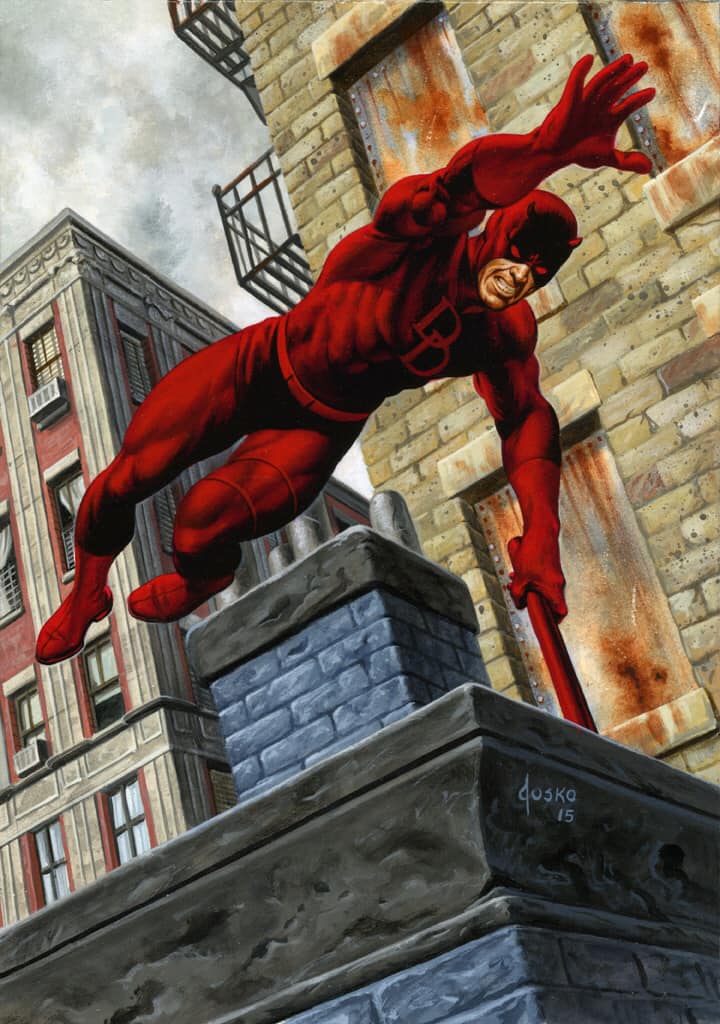
Daredevil (Holofoil) by Joe Jusko, 2016
The other 2016 insert gives us Daredevil in action, as he moves effortlessly through the tenement buildings of New York City. We’re off balance with a tilted horizon line, not unlike the hero himself, and it allows the viewer a bit of the same vertigo Daredevil might experience as he moves sightlessly through the city.
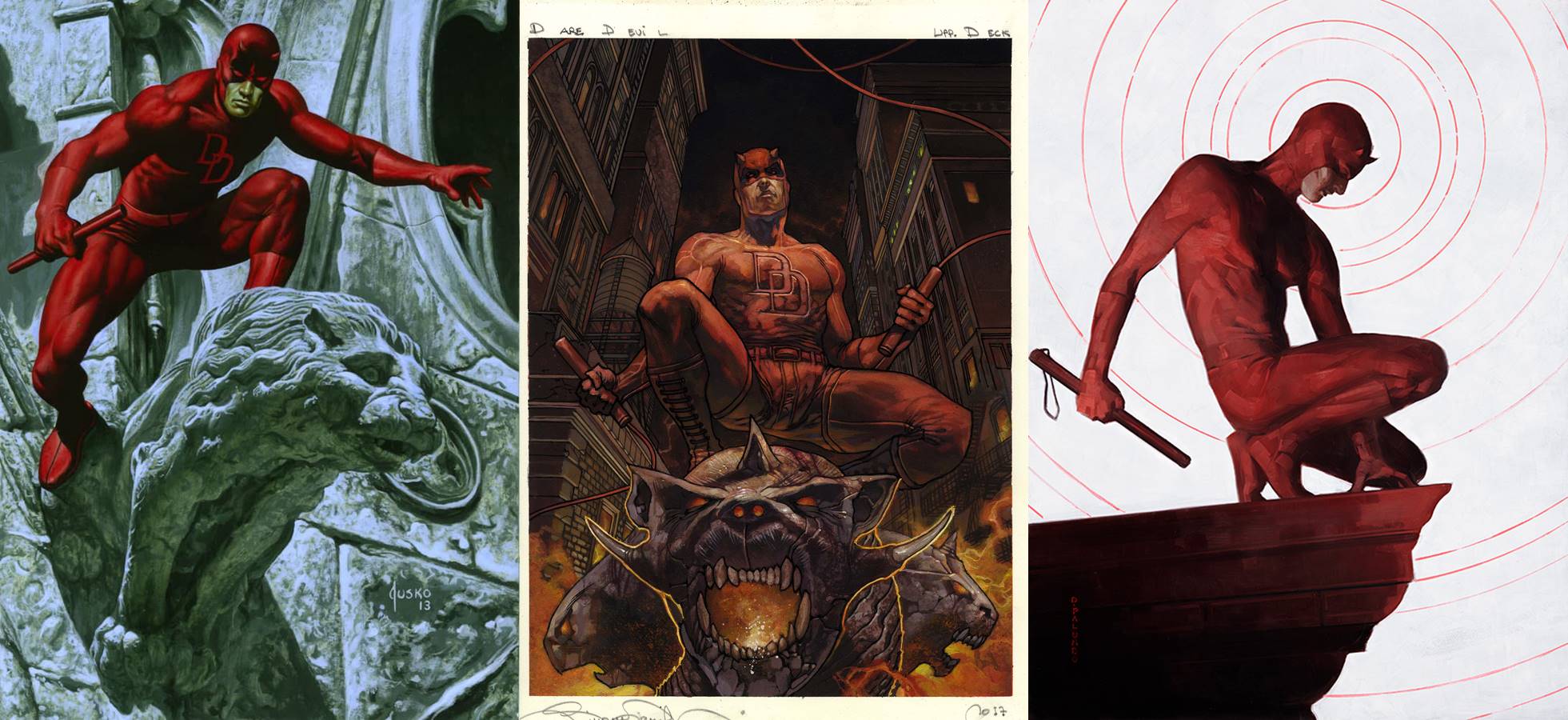
Left to Right Daredevil (Base) by Joe Jusko, 2016; Daredevil by Simone Bianch, 2018; Daredevil by Dave Palumbo, 2020
For the base set of each series we see Daredevil in much the same way, perched high above the city on some manner of outcropping, surveying the scenery by way of heightened senses. Jusko paints him at an angle on one of the most realistic gargoyles I’ve seen in trading cards. Bianchi turns up the heat of Hell’s Kitchen with reds and oranges, and shows the hero dead on to the viewer. And then Palumbo goes quiet, a visual sonar emanating from the man himself against a white background. Remember all of his paintings have a song, so queue this up while you take a look; you won’t be disappointed.
Palumbo’s Daredevil is one of his best in his 2020 lineup, and one of the strongest paintings across all three years.
Elektra
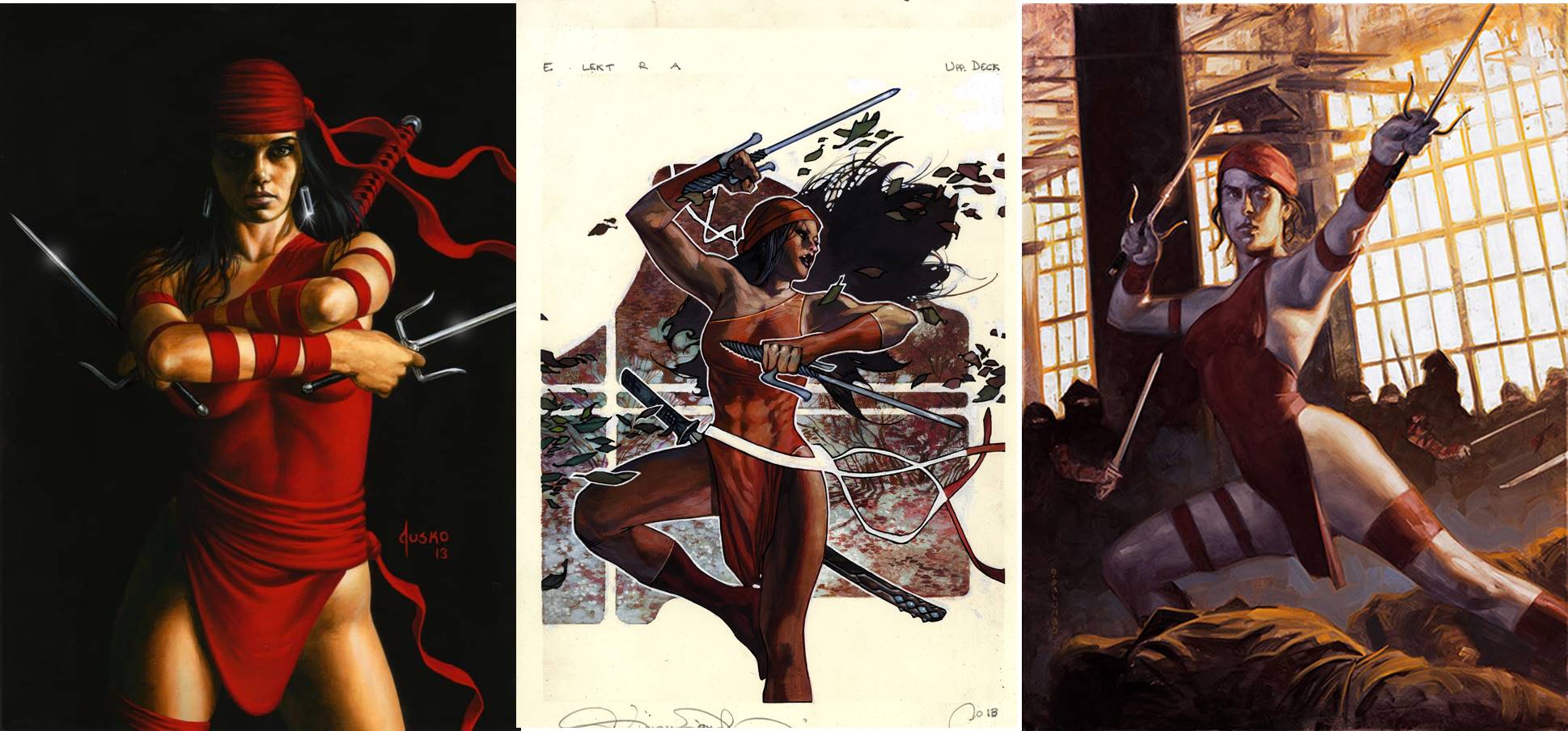
Left to right: Elektra by Joe Jusko, 2016; Elektra by Simone Bianchi, 2018; Elektra by Dave Palumbo, 2020
Elektra Natchios is the long time love interest of Matt Murdock, and has appeared alongside the masked man throughout the 1980s. According to Jusko in his book, she was not initially slated for the 2016 set, but after several characters were pulled and by his suggestion she made it!
I love her emergence from the darkness, the stark red against the deep black. Bianchi also employs the idea of negative space, but this time exchanging the black for white, creating an entirely new portrait that’s full of motion, as if she’s to fight right through the frame. Palumbo’s Elektra is all business, with sexiness and suave cast away for a look of dead seriousness and determination. These are three images that show three completely different sides of this single character, and those differences in artist interpretation is what these Masterpieces series are all about.
Luke Cage
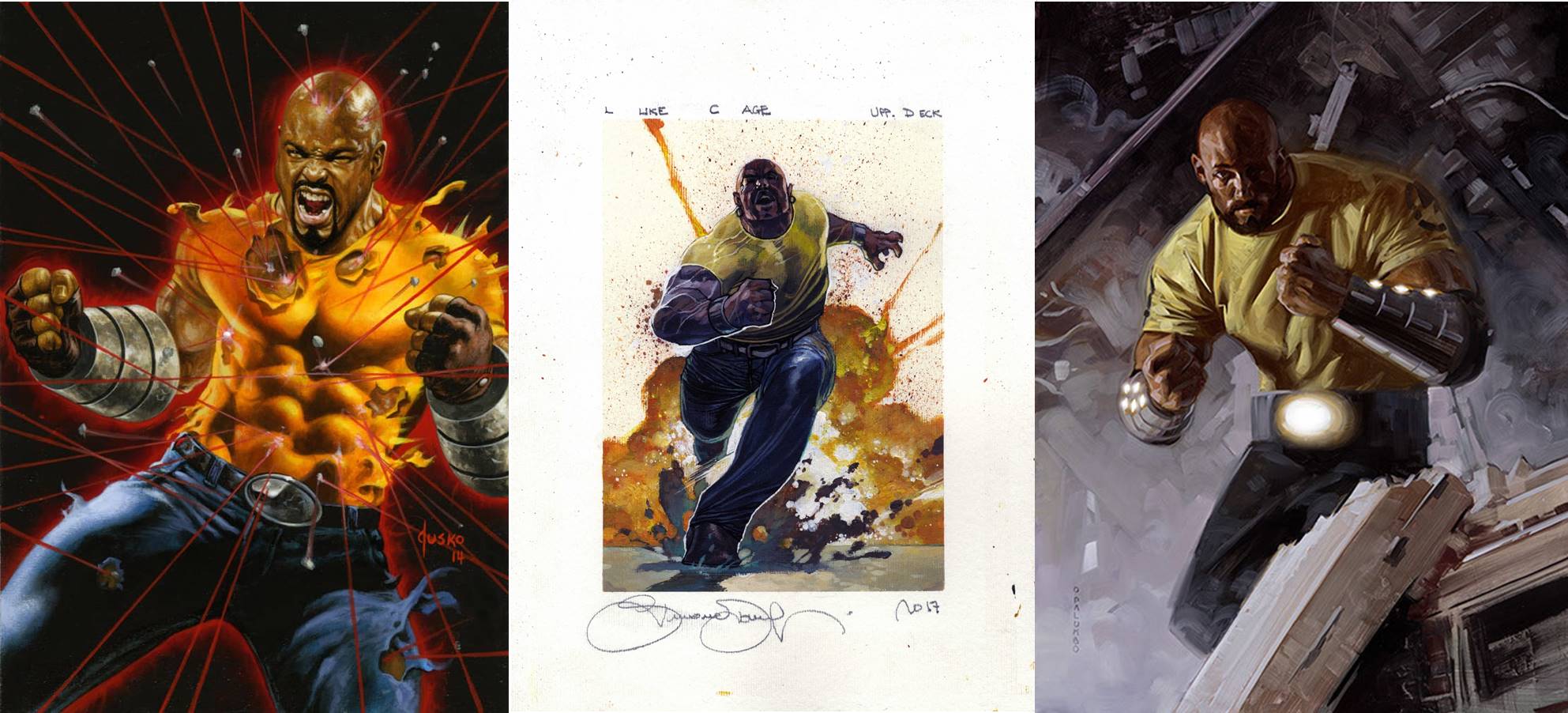
Left to right: Luke Cage by Joe Jusko, 2016; Luke Cage by Simone Bianchi, 2018; Luke Cage by Dave Palumbo, 2020
Luke Cage, a.k.a. Power Man a.k.a The Hero for Hire has been a part of Marvel since the 1970s, and was one of Marvel’s first black superheroes to be featured as the title character of his own series. His powers of superhuman strength and unbreakable skin lend themselves to simpler compositions, with no strange appendages or locations to draw on, but it makes these three portraits no less striking.
Jusko has employed the primary color palette, a red background, a yellow shirt, and blue jeans, to distill this character down to his essence, a realistic portrait of man as hero. Bianchi shows a beefier Cage in action on a white ground, as if to silence the surroundings and draw us into the action. And Palumbo frames Cage amongst the rubble, a ready-for-action depiction that shows his painterly style at it’s best.
She-Hulk
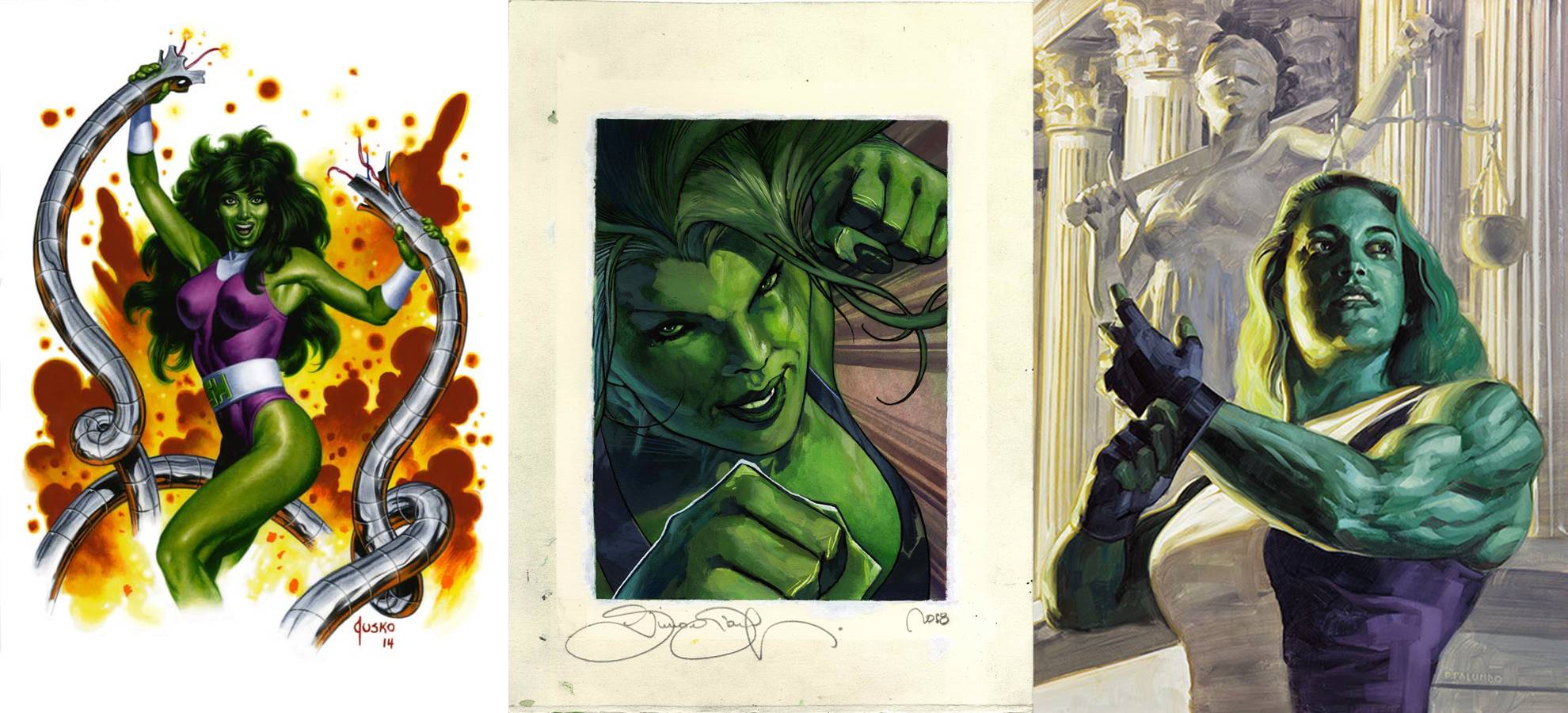
Left to Right: She-Hulk by Joe Jusko, 2016; She-Hulk by Simone Bianchi, 2018; She-Hulk by Dave Palumbo, 2020
Next we come to She-Hulk, who ties in as the lawyer of the Heroes for Hire mentioned above, as well as the short term love interest of Power Man himself. Each of her appearances are quite different across these years: Jusko went retro cheesecake, with the bodybuilding heroine showing off her strength, Bianchi gives us a super-close up portrait, and for my regular readers you know how much I like these up close and personal encounters, even if it means the business end of a fist. Palumbo’s version is pure fun, and we see none other than Orbit Books Art Director Lauren Panepinto who served as reference for the image. It’s a strong, stronger, strongest timeline, and one only visible when placed side-by-side as we’re doing.
Black Widow
You may have noticed that Black Widow was absent from our Avengers series, and that was because she was already written into this feature to highlight her often overlooked relationship and involvement within the Daredevil storyline (and also because that article ran very long, let’s be real). We see Black Widow two ways:
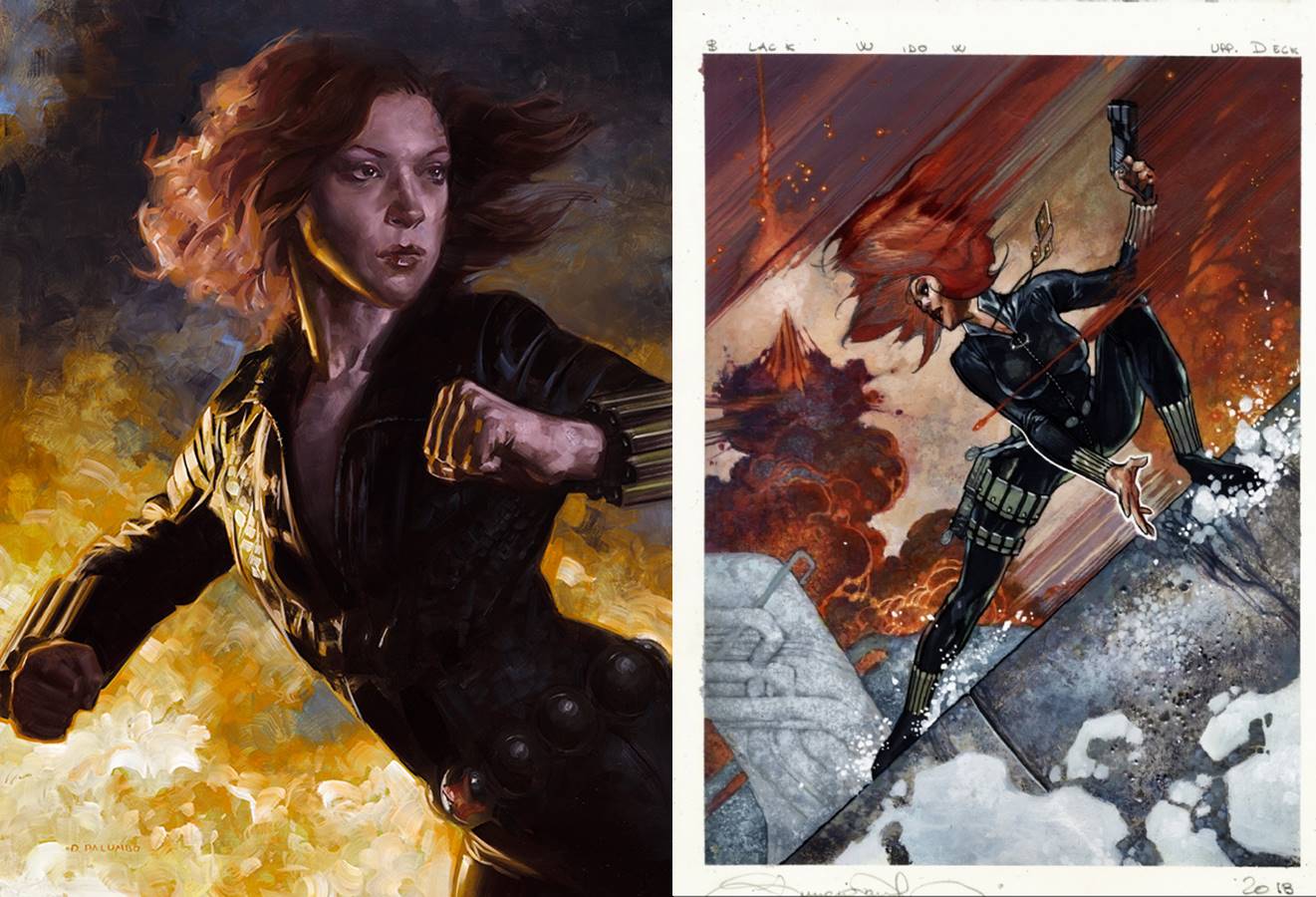
Left: Black Widow (Base) by Dave Palumbo, 2020. Right: Black Widow by Simone Bianchi, 2018.
The first is Black Widow in action, captured in the middle of the fire fight with all the flame and fury of battle. Palumbo has her emerging from the frame with the most incredible expression of resolve, and Bianchi’s exaggerated composition pulls your eye through the entirety of the frame.
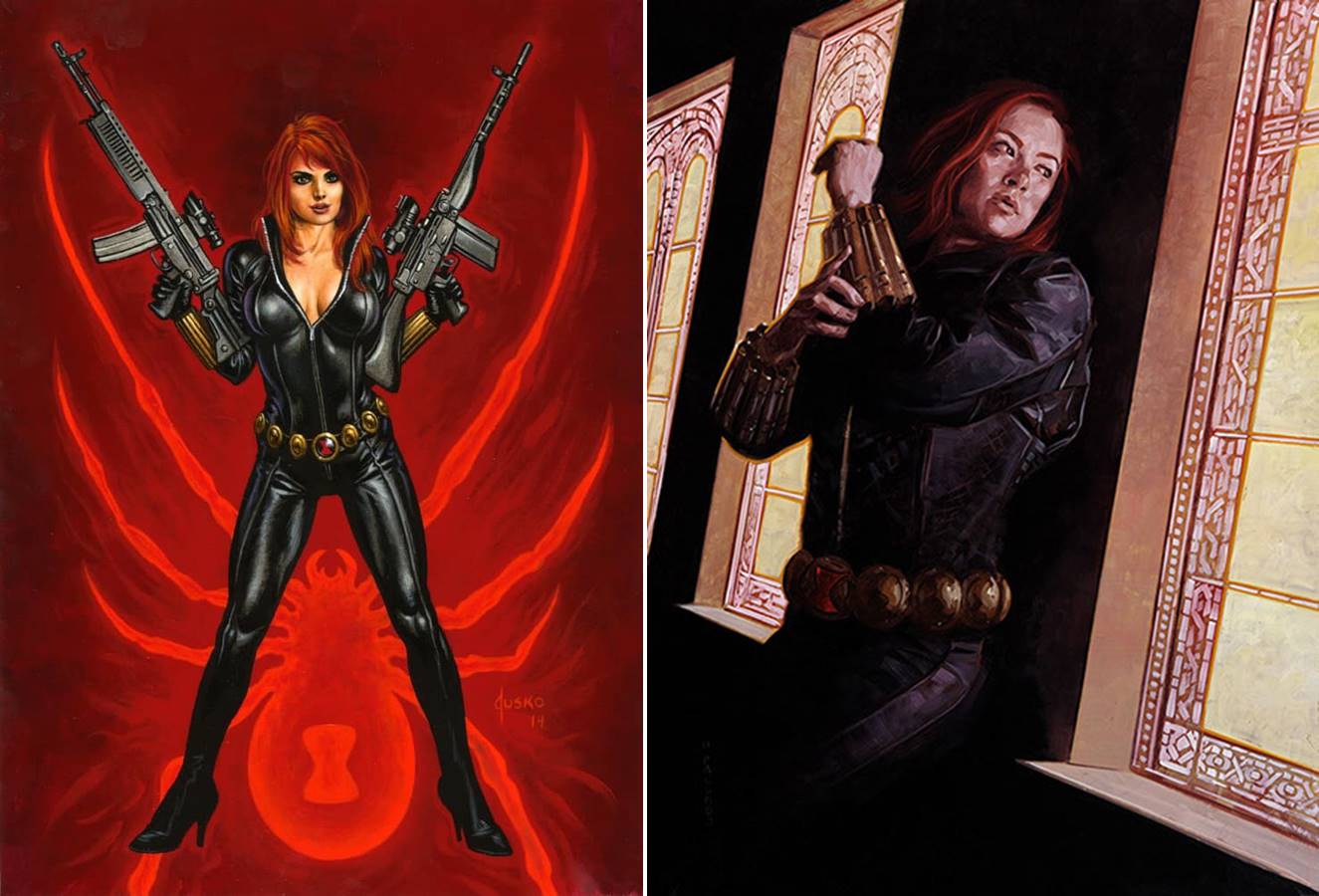
Left: Black Widow by Joe Jusko, 2016. Right: Black Widow (Canvas Gallery) by Dave Palumbo, 2020.
There is another side to Natasha however; she’s not always fighting. Jusko again uses red and blacks to create a contrast that pops off the card, and you can see the spider and her signature symbol glowing in the background. Palumbo’s second work, for the Canvas Gallery series, feels like an Old Master painting, with light shining through the stained glass and everyone, viewer included, holding their breath for what might be around the corner.
Wrapping Up
Whether it’s three complementary portraits that showcase a hero as we know them best, or three completely different takes that give fans all sides to these multifaceted folks, the Marvel Masterpieces series are unparalleled in their ability to invoke an artist’s vision of the Marvel universe. In this grouping we just happened to get both, and you can see just how similar, how different, and how intertwined these paintings and characters can be. Who would have thought nearly a decade worth of artwork would have such a strong connection.
Our next edition of Parallels will blur the focus as we check out the so-called Anti-Heroes of the Marvel universe, trying to decipher intentions across three years of some of the most interesting characters in the series There are only two Parallels articles left, and with the Marvel Masterpieces 2022 announcement due later this year, there are a lot of exciting things on the horizon. You can keep up with all things Marvel Masterpieces 2020 by following me on Twitter. Feel free to ask questions or retweet to continue the conversation. Thanks and see you next time!

